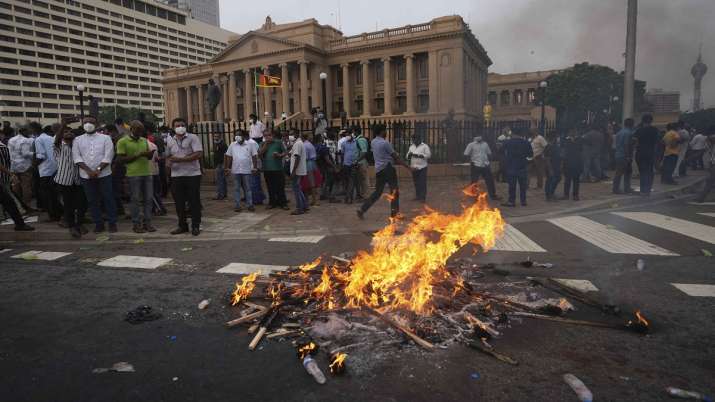
Supporters of Sri Lanka’s main opposition party burn placards during a protest outside the presidential office in Colombo, Sri Lanka.
Sri Lanka, the island nation, due to its worst economic crisis due to lack of fuel, electricity and essential commodities, is pushing citizens into the streets who are protesting against the administration. Almost all cabinet ministers in the ruling government have resigned, leading to policy paralysis in the country. Meanwhile, Sri Lankan President Gotabaya Rajapaksa fired his brother and Finance Minister Basil Rajapaksa from his job. He has now invited opposition parties to join the Unity Cabinet to deal with the public’s anger against the difficulties. India has extended a helping hand to the neighboring country with its economic relief package, which will help overcome the current power shortage in the country. Former Sri Lankan Finance Minister Tulsi had discussed the Indian economic relief package. Justice Minister Ali Sabri has replaced Tulsi as the new foreign minister.
- Basil Rajapaksa was due to fly to the US to meet with the International Monetary Fund (IMF) for a possible relief package to tide over the unprecedented economic crisis, but has now been sacked. He was at the center of anger within the ruling Sri Lanka Podujana Peramuna (SLPP) coalition. Last month, at least two ministers were sacked from the cabinet because they publicly criticized Tulsi.
- All 26 cabinet ministers submitted resignation letters on Sunday night. After the resignation of cabinet ministers, at least three other new ministers took oath.
- GL Peiris has been sworn in as the External Affairs Minister while Dinesh Gunawardene is the new Education Minister. Johnson Fernando has been made the new Minister of Highways.
- The new appointments came after President Gotabaya invited all political parties to join the Unity Cabinet as part of the government’s bid to tackle public anger against the ongoing hardships caused by the island nation’s worst economic crisis. .
- People gathered on the streets and demanded the resignation of the President. The protests imposed a curfew after the president declared a state of emergency. As the protests intensified, the government on Sunday banned social media for 15 hours.
- People violated the curfew by protesting against long queues for fuel and gas and hours without electricity. Central Bank Governor Ajit Nivard Cabral has also announced his resignation. Cabral, 67, was blamed for his harsh stance on Sri Lanka for seeking an economic bailout through the IMF Structural Adjustment Facility.
- Despite their protests, the government approached the international lender for support over the past fortnight. During his rule, the Central Bank was accused of printing large amounts of money, triggering inflation.
- He was blamed for his harsh stance on Sri Lanka seeking an economic bailout through the International Monetary Fund’s (IMF) Structural Adjustment Facility.
- The country is battling the worst economic crisis since independence from the UK in 1948. This is due to a shortage of foreign exchange, which is used to pay for fuel imports.
- India recently extended a USD 1 billion line of credit to Sri Lanka as part of its financial aid to the country to tide over the economic crisis after the previous USD 500 billion loan in February to help buy petroleum products. announced.
,With inputs from PTI,
read also , Sri Lanka’s cabinet ministers resign with immediate effect amid economic crisis
read also , Indian soldiers left for Sri Lanka? Here’s what the Indian High Commission says